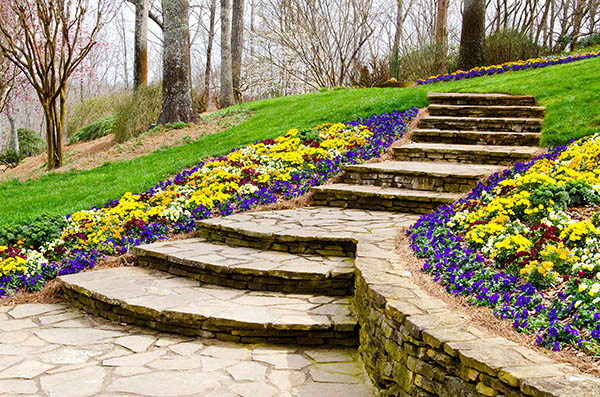Attain a Beautiful Outdoor Oasis With Thoughtful Steep Hill Landscape Design Solutions
Transforming a steep hillside into an exciting outside oasis provides unique difficulties that need ingenious landscape design options. Techniques such as terracing, the installation of preserving walls, and the option of native plants play essential roles in this process. In addition, including water functions can additionally improve the landscape's appeal.
Understanding Steep Hillside Obstacles
Landscaping on high hills offers distinct difficulties that need careful factor to consider and strategic preparation. The inclination of the surface can bring about problems such as dirt erosion, water runoff, and minimal access, all of which must be dealt with to create a practical and visually pleasing outside space.
Among the key concerns with high hillside landscape design is erosion, which can arise from hefty rainfall or inappropriate drainage. This not just influences plant wellness but can likewise endanger the stability of the slope. Implementing efficient disintegration control steps, such as planting deep-rooted greenery or making use of compost, is vital in protecting the integrity of the landscape.
Creating With Terracing Methods
To mitigate the difficulties presented by steep hills, integrating terracing techniques can be an efficient service. This design strategy changes a sloped landscape right into a collection of flat, level areas, producing a visually striking and practical outside space. Terracing not only aids to prevent dirt disintegration however additionally helps with much better water drain, which is vital in maintaining the wellness of plants and the security of the hillside.
When making terraces, cautious consideration of the incline's angle and the soil type is essential. Each balcony must be strategically placed to optimize sunshine exposure while reducing the threat of runoff. The usage of native plants on each degree can boost biodiversity, promote sustainability, and decrease maintenance needs. Furthermore, incorporating paths in between terraces can boost access and motivate exploration of the landscape.
Terraced gardens can offer multiple objectives, consisting of vegetable production, ornamental display screens, or exterior seats locations. By utilizing products that mix harmoniously with the surrounding setting, the terracing can boost the general visual allure of the building. Inevitably, thoughtful terracing transforms high hillsides right into functional, beautiful areas that invite interaction and enjoyment.
Carrying Out Retaining Wall Surfaces
When confronted with the obstacles of steep terrain, applying retaining wall surfaces can give both architectural support and aesthetic improvement to a landscape. These wall surfaces serve to avoid soil disintegration, support inclines, and develop level locations for gardening or entertainment use. Steep hill landscaping. By effectively taking care of water runoff and reducing dirt activity, preserving walls secure your landscape financial investment while boosting safety

Professional setup is critical to guarantee the longevity and efficiency of maintaining walls. Proper water drainage systems should be incorporated to soothe hydrostatic pressure, preventing structural failure. Consulting with landscape specialists will make sure that the design straightens with your overall vision while sticking to local guidelines.
Choosing Indigenous Plants
Choosing native plants for your landscape design uses many eco-friendly and aesthetic benefits. Steep hill landscaping. Indigenous plants are adjusted to the neighborhood environment and soil conditions, calling for much less water and upkeep compared to non-native types. This flexibility not only preserves resources however also promotes a healthier ecosystem, as indigenous plants sustain local wildlife, including pollinators such as and butterflies
Incorporating native flora into your high hillside landscape design can boost soil stability, lowering disintegration and promoting a balanced ecological community. Deep-rooted indigenous plants aid anchor the soil, making them optimal for sloped areas. These plants often exhibit dynamic shades and varied structures, producing a visually attractive landscape that balances with the surrounding setting.
When picking native plants, consider their growth routines, seasonal rate of interest, and compatibility with other species. Organizing plants with similar water and sunshine requirements can lead to a more cohesive layout, while additionally streamlining upkeep. By choosing indigenous plants, you not just grow a lasting outside oasis yet also add positively to the neighborhood biodiversity, guaranteeing that your landscape thrives for years to come.
Incorporating Water Attributes
Incorporating water features right into your steep hill landscape design can dramatically improve both the visual charm and ecological capability of the area. The audio of streaming water creates a calm ambience, while visually, it can act as a centerpiece that attracts the eye and includes depth to the landscape.
When selecting water attributes, think about choices that enhance the all-natural shapes of your hill. Waterfalls, as an example, can cascade the incline, producing visual interest and promoting healthy drainage. Ponds can likewise be incorporated right into the layout, urging local wild animals and giving habitats for numerous types.
Moreover, the placement of plants around these Click Here features is vital. Native aquatic plants not just boost the appeal of the water feature but likewise add to its environmental balance by filtering system contaminants and supplying food for neighborhood fauna.
Maintenance is another vital variable; ensure that your water feature is made for very easy maintenance. An appropriately built function will call for minimal treatment, allowing you to enjoy the beauty and harmony it provides without extreme labor. Ultimately, thoughtfully bundled water functions can transform your high hill landscape right into a captivating exterior oasis.
Conclusion
To conclude, transforming a high hillside into a gorgeous outside sanctuary necessitates thoughtful landscape design strategies that attend to disintegration control and ease these details of access. The assimilation of terracing methods, the execution of preserving wall surfaces, and the selection of native plants are important elements of efficient style. Furthermore, including water attributes enhances both aesthetic appeal and drainage effectiveness. With cautious planning and execution, steep hills can become serene retreats that provide both performance and visual pleasure.